Fuso’s happy place
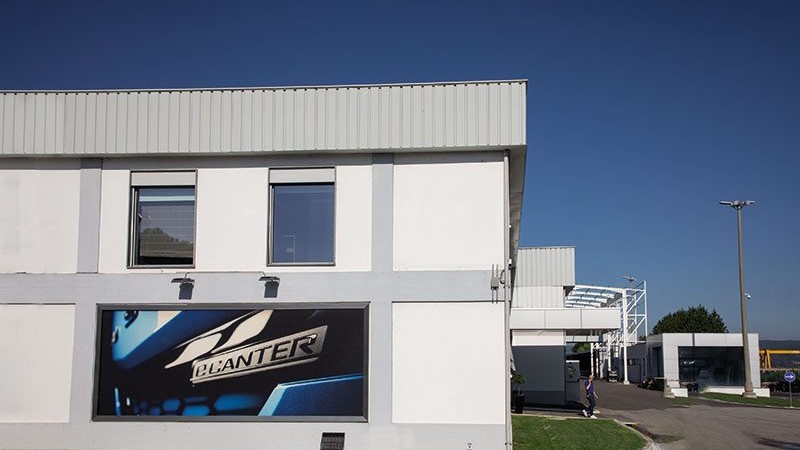
For most of us, a commercial vehicle assembly plant in Europe conjures up images of huge buildings in big cities and robots – lots of robots. That might be the case in some instances, but it’s as far from reality as you can imagine when you’re talking about the Fuso plant in Tramagal, Portugal.
In the event you’re smiling a little more than normal when you take delivery of your Fuso eCanter, finding it a ‘happy’ place in which to work over the months and years that follow, thank the truck. Karma, feng shui, the influence of ethereal things; if that’s your buzz then, rest assured, every eCanter comes with three payloads worth of the good stuff.
You might well assume your little truck was spat out of a windowless behemoth in a grey industrial hinterland somewhere in the world. Not so. When the itinerary on our recent visit to Europe said ‘visit to Fuso Europe plant, Tramagal’, I certainly assumed many wrong things.
A beautiful countryside location, windy country roads, streams, picture-postcard villages, incredibly friendly people… and vineyards. They are the stuff of your little eCanter’s European birthplace, in gloriously sunny Tramagal, 140km north of Portugal’s capital city, Lisbon.
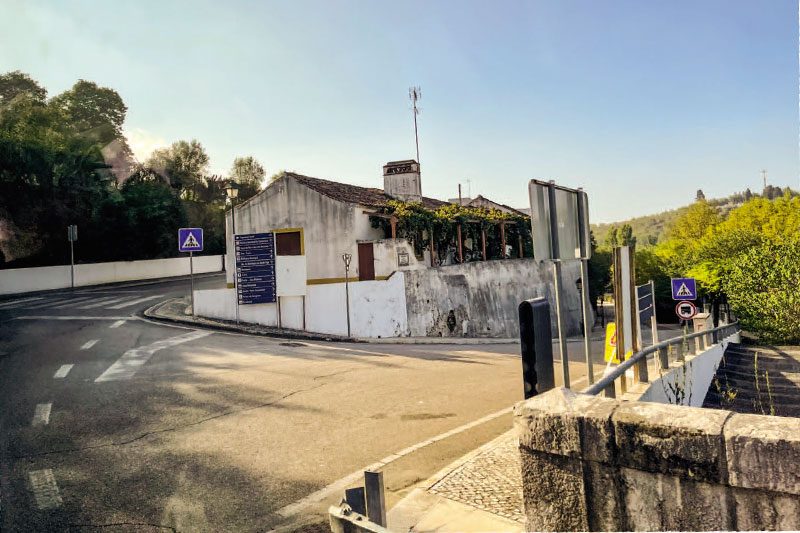

In fact, the location is so unique, you could have been excused for thinking our good bus driver was lost, and for a short time after leaving the motorway, he was. Thankfully some friendly locals outside a village fire station soon had him meandering with purpose again.
The positive indications as we got close began to increase with vehicle transporters coming towards us loaded with gleaming new Canters, plus the occasional ‘FUSO’ pointer buried among the sign trees in villages.
Then, we turned up a lane, rounded a tree-lined curve, and there, high on a sign, were three big diamonds with FUSO written beneath.
Driving into the parking area, and stepping out, there’s a picture of every staff member on the side of the main assembly building, such is the sense of community in this place. Finding multi-generational family members in the workforce is not hard by all accounts.
Of course, the question is, how did a Fuso plant end up here? “People often say it’s in the middle of nowhere,” says plant CEO Arne Barden. “It’s not really.”
The plant was established in 1964 by the Duarte Ferreira family from Tramagal for the production of Berliet military vehicles. That continued for 10 years, after which it assembled for other marques until 1980, when production for Mitsubishi Fuso commenced. Ownership transitioned to Mitsubishi Motors Portugal in 1990 and on through the various Mitsubishi and Daimler manoeuvrings to where it is today, part of Daimler’s Mitsubishi Fuso Truck and Bus Corporation.
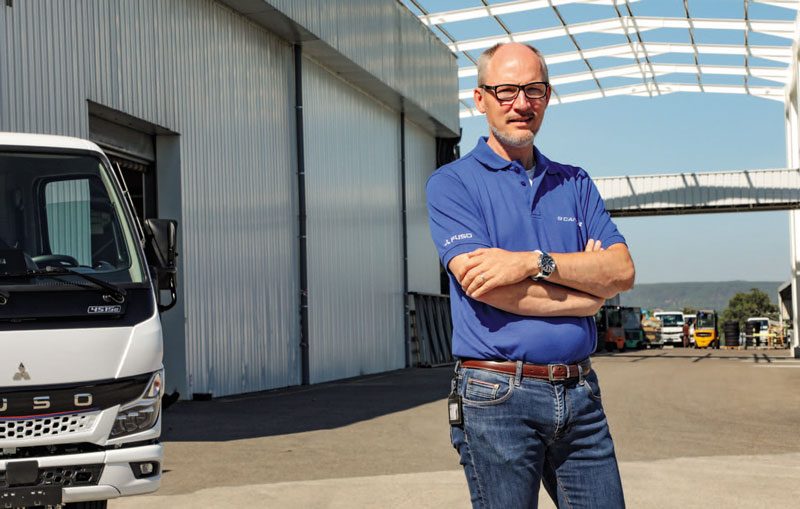
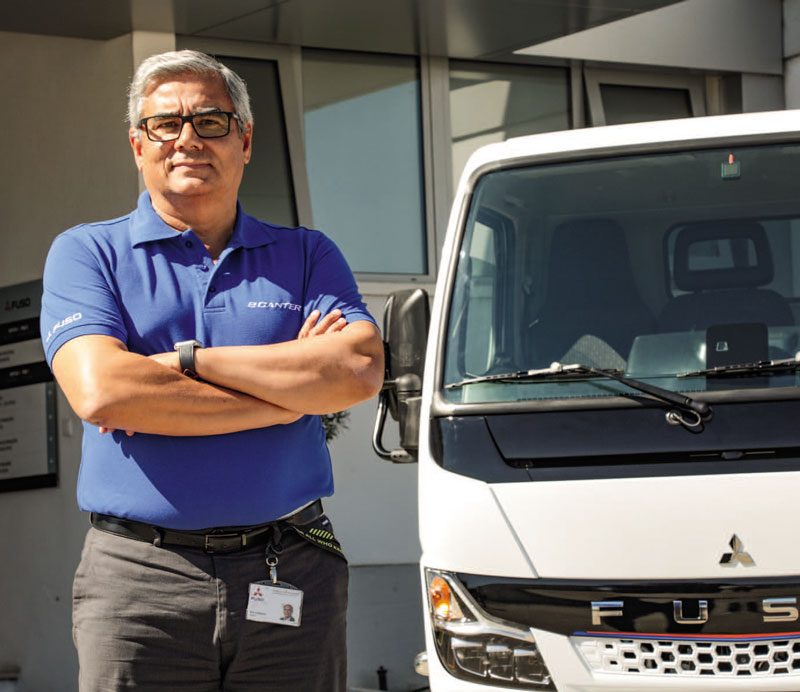
Arne has been there since March this year. A key Daimler man, the 51-year-old has been with the company since 2001, working in its Europe, India, and Singapore operations.
“It was an easy choice to come to Tramagal. In a previous role, I had been part of the supply team to this plant, so I knew it, its processes, and many of the people.
“Although in Portugal, we are part of Fuso in Japan, which at times my German colleagues can find a little frustrating,” he says with a well-meaning grin.
Covering 158,546m2 with 40,696m2 undercover, the plant employs 600 staff producing Fuso’s Canter product in both ICE and BEV forms. Markets include Europe and North Africa for the ICE product, reaching much farther afield for eCanter, including little- old-us.
Annual output is around 12,000 units, at the rate of 56 per day, and to date, the plant has built more than 300 eCanters.
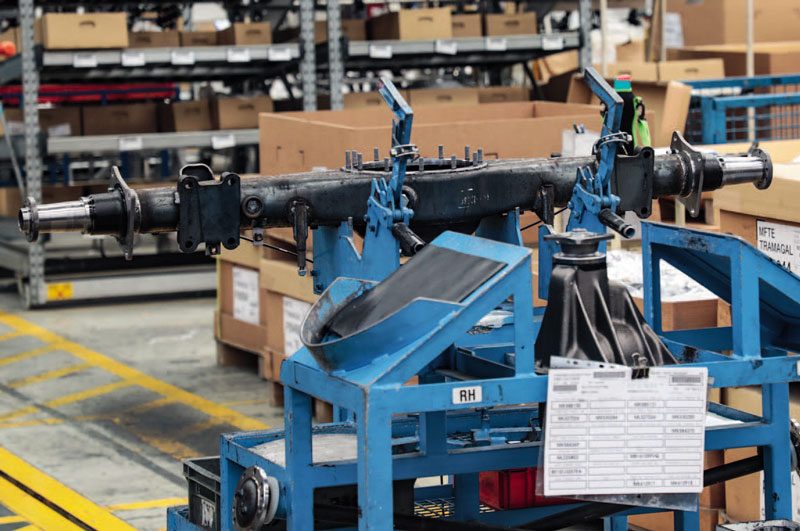
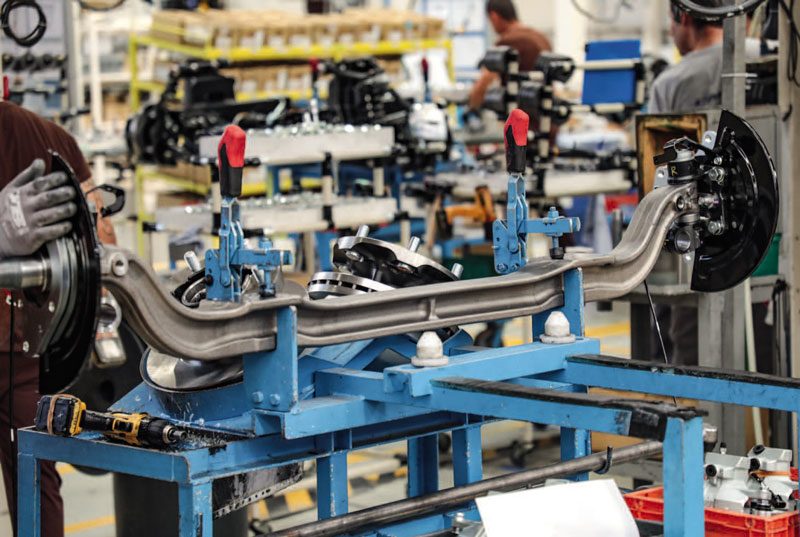
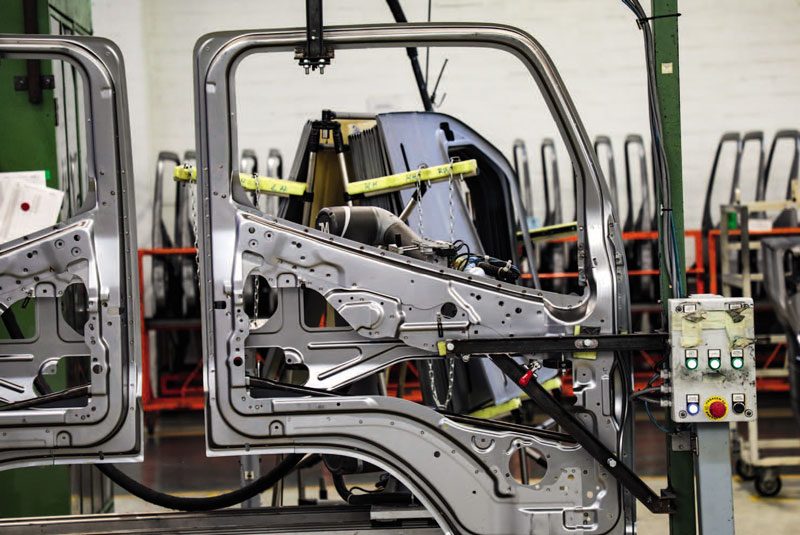
The pride in their history with the Canter model is clearly evident among the folk there, especially so with eCanter, where there’s a definite sense of contribution to a better tomorrow.
Tramagal’s history with the e-product goes all the way back to the Canter E-Cell prototype in 2014, through eCanter Series 1, and beginning next year, production of the Series 2 will commence.
The Series 1 truck is produced on a boxed production line, meaning the batteries, high voltage components, and EV ecosystem are installed adjacent to the main line for a portion of the chassis journey through the factory. Series 2 will be assembled in the main line with the ICE trucks, which is aligned to Daimler’s wider BEV assembly strategy.
“We’re in the midst of working out the processes to make that happen,” says head of operations and 30-plus- year veteran of the plant, Rui Correia. “Currently an ICE truck takes six hours from frame rails to finished, and an eCanter about two to three hours longer. Much of the time will be saved in preassembly processes.”
Woah to go!
A compact factory by global standards, both Arne and Rui confirmed there is room for expansion.
Engines and transmissions for the ICE trucks – and battery packs, EV sub-assemblies, eDMs, and transmissions for the BEVs – all arrive as components. Front axles come in SKD (semi knocked down) from Japan, and cab panels arrive pre-stamped. All other components arrive CKD (completely knocked down) in part batches rather than the vehicle batch system commonly seen in car assembly. By their nature, trucks are not a one-size-fits- many product, as a car is, so batch by part allows a much higher level of individuality.
With the rails sourced locally, Tramagal assembles the frame, riveting it all together with a powder-coated finish chosen for environmental reasons. Rear axles are fully assembled on a line designed and built by the Tramagal team. Something they are rightly proud of.
Cabs are spot-welded together using between 1600 and 2000 spot welds, depending on the model. Once assembled, the cab is prepared for coatings, primed, and painted. This is one of three areas you will find autonomous robotics – for reasons of uniformity of application and increased respiratory safety.
Like all series production lines, it’s a symphony of coordination with preassemblies of cabs, dashboards etc, all occurring in different parts of the factory enroute to a rendezvous with the chassis.
Key to that all working is the warehousing function. Orders are triggered via sensors as components near run-out on the line. Replenishment occurs via small autonomous and semi-autonomous robots, as well as manually for specific parts.
Kitting, meaning the picking of multiple items to make up preassembly components – dashboards, light assemblies etc – happens via pick-to-light.
All Canters – certainly every eCanter – have a home to go to; there are no stock units built. That, of course, adds significant pressure to the accuracy of assembly line replenishment.
With its high-voltage components, the eCanter brings with it specific training considerations, resulting in a qualification requirement from CEO to the line workers that even implicates plant accessibility in certain areas.
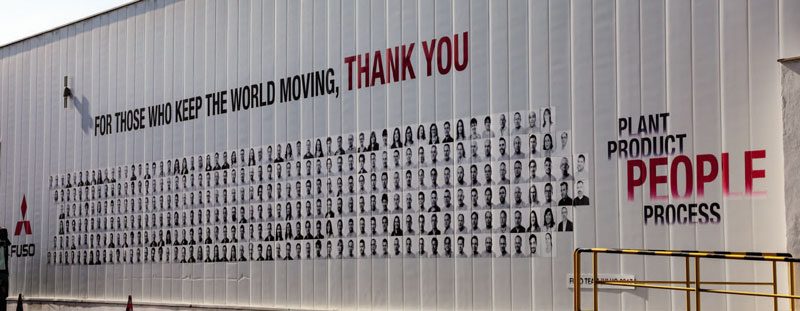
The plant is light and airy, and a friendly wave and smile from the team as we walk through is never far away. Arne tells us that Tramagal’s location can make it less appealing for the young and ambitious. However, once they’ve had a family and are in search of a lovely place to raise children, it comes to the fore. That has benefits at all levels of the business.
Rui shows us the on-site gym, a well-equipped, immaculately presented space that he says is extremely popular. “It was a staff initiative, and everyone has access.”
At the end comes the beautiful marriage between cab and chassis, and at last, a brand-new truck is born. Well almost. It’s at this point that the ECU has life breathed into it via a data drop and the new Canter instantly knows who and what it is.
Quality assurance is something that happens all through the build process, with random checks undertaken online, and remotely via components and sub- assemblies removed for more intense scrutiny. A thorough final inspection and test drive take place post-production, and once everything is signed off, the Canter is ready to go to its new home… by road.
Although there’s an adjacent railway line, road and sea are the logistical modalities of choice. “We talk to rail providers each year, but they are unable to provide the flexibility or pricing that works for us,” said Arne.
Although eCanter Series 2 will enter production in 2023, the current model will remain available as long as there is sufficient demand from the customer base. Initially, Series 2 production will include both wide and narrow cabs, and multiple wheelbases in the 4.2 to nine-tonne GCM range. Double cabs will come later.
Fuso, Tramagal. The overwhelming impression was a clean, modern factory in a fabulous location staffed by happy, friendly people of all ages. Surely that has to be an environmental winner on every level.
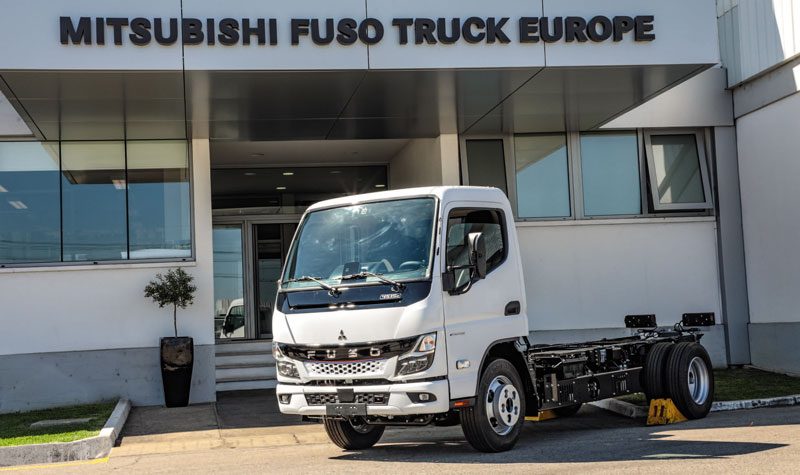
Worthy of its charge
Marta Nalha is an environmental engineer working at Fuso Tramagal, driving the business’ environmental targets. A decade after commencing their crusade to make the plant worthy of the history-making truck produced, in 2022 Fuso Tramagal will reach carbon neutrality, with net-zero emissions in their sights by 2030, and carbon positive a decade after that.
No stone is being left unturned in their pursuit, with the broader strategies divided into manageable projects. “We still have to put forward a solid business case to secure the funding for each project,” says Marta, “but there’s certainly an appetite for environmental objectives at the senior levels.”
Improving component performance in the plant, eg new paint lines, more efficient pumps, compressors, and mastic ovens, run concurrently with improvements in support systems such as the photovoltaic plant, green electricity, intensive recycling, and the elimination of paper. In the next half decade there will be a move to using natural gas through the plant also. One of the next focus points will be the shift to EVs for all of the plant’s internal and warehouse operations.
Interestingly, there’s no government subsidy or incentive for businesses seeking CO2 neutrality in Portugal. However, before you roll your eyes too far, there’s an element of ‘we’ve done our bit’, in there. Portugal was one of the first countries in Europe to ditch coal-fired power stations, with one such ghost of the country’s past visible on the way to Tramagal.
To the question of using suppliers whose environmental house and emissions are in order? Arne Barden says, “Yes, we are pushing into that space, but you can’t ask others to clean up their backyard until yours is where you want it.”
 And you thought you knew Portugal!
And you thought you knew Portugal!
Located in Europe’s southwestern corner, Portugal enjoys fabulous weather, great wine, and fantastic food. Roughly one-third the size of New Zealand with twice the people – in terms of friendly folk, we may have met our match. Life expectancy is 81.5 years (see, red wine is good for you) and the country enjoys high rates of education, currently earning a name as a rising IT hub in Europe. Daimler itself has a start-up subsidiary in Lisbon called tb.lx, a business unit working in the area of connectivity.
But for a peak time in the annual calendar, Portugal is energy self-sufficient with 60% renewables in the form of solar, water, and wind. Imported energy comes from the USA and Nigeria, so Putin’s shameful display is not having the effect it is elsewhere in Europe.










